
|   |

|   |
Remembering the legacy of a Guru - Veejay Sai, Bangalore e-mail: vs.veejaysai@gmail.com Photos courtesy: Srjan September 21, 2012 Odisha’s largest cultural ambassador and the most popular representative of the Orissi dance form in the 20th century, Guru Kelucharan Mohapatra needs no introduction to the world of Indian classical performing arts. The annual awards festival organized year after year by his able son Ratikant Mohapatra completed its eighteenth year successfully under the aegis of Srjan in Bhubaneshwar. An eclectic mix of music, dance and theatre, the festival was held at the Rabindra Mandap, which was lit up like a jewel, to packed halls every evening from 5th to the 9th of September. The music concerts included a Ghazal evening by Hariharan, a percussion jugalbandi with Vidwan Karaikudi Mani on the mridangam and Pandit Anindo Chatterjee on the tabla and Bangalore Amrit on the khanjira and a fusion concert of young flautist-duo Pankaj and Paras Nath. The dance recitals everyday came from a mixed bag. One would assume that since it was a festival in Odisha, dedicated to such a popular Odissi guru, there would be one too many Odissi performances. But surprisingly the programming of the festival had a good balance of several music and dance forms. Day 1 After the inaugural ceremony by the Governor of Odisha, Shri Muralidhar Chandrakant Bhandari, who was an evident art lover in the speech he gave, the first evening of the festival had an Odissi recital by Madhavi Mudgal. She commenced her performance with a Pushpanjali tuned to Adi Shankara’s famous ‘Jagannathashtakam’. No performance of Odissi is ever complete without the immortal lines ‘Jagannatha swami nayana pathagami bhavatume’ being performed in obeisance to their most famous State-god. Following this was ‘Aye Ghana Kalare’ set to Raag Desh written by Kavi Samraat Upendra Panja. The pangs of a Virahini Nayika were depicted in the loneliness she experienced as the thundering clouds, dancing peacocks and an impending monsoon only added to her longing. After a Pallavi in raag Jhinjhoti set to Khemta taal, choreographed by Madhavi to music composed by her brother Pt. Madhup Mudgal, she concluded her performance in another choreographed piece taking three ashtapadis from the Gita Govindam. Opening with ‘Madhave makuru manamayi’ where Radha’s Sakhi is pushing her to go meet her lover, leaving her pride aside, to ‘Kshana madhuna narayanamanugatam’ where the lover Krishna willingly offers himself to Radha in repentance and ending with ‘Kuru yadunandana’ where Radha , now the Swadheenapathika, is ready to submit to her lord in a divine union. With music composed by Pandit Jasraj, Madhup Mudgal and Bhubaneshwar Mishra to each of the ashtapadis, Madhavi’s dance (though she was recovering from a bout of illness) had its sparks. With high-pitched but excellent singing by Manikuntala Bhaumik, Purnachandra Maji, melodious flute by Srinibas Satpathy (who is becoming a regular feature and an asset to every Odissi performance), sitar by Yaar Mohammad and the very pretty Arushi Mudgal on the manjira (who was missed on the stage, usually accompanying her aunt), the first evening’s recital concluded with a Ghazal performance by Hariharan. There couldn’t have been a better gift to the great Guru from one of his famous protégés on ‘Teacher’s Day’. 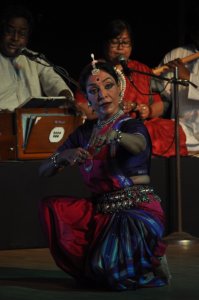 Madhavi Mudgal 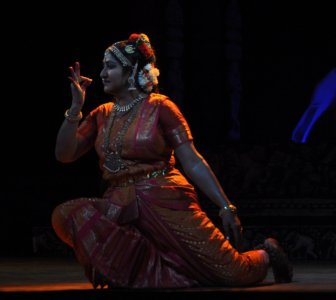 Manju Barggavee Day 2 The second evening saw a Kuchipudi recital by Manju Barggavee. With evident fatigue and reeling under a severe bout of fever, it made it difficult to even watch her perform. The tall stately dancer commenced her performance with an ashtapadi ‘Sanchara dhadhara sudha madhura dhwani’ set to a Ragamalika. One could see flashes of brilliance in how her guru, the late Vempati Chinna Satyam tailored the dance form to the ashtapadi in his choreography. At times, Sudharani’s voice did get a bit shrill when she tried to desperately reach the higher octaves, after having started at a high pitch, but the violin by Anjaneyulu balanced it. By the end of this item, Manju’s fatigue was visible and got most of us in the audience worried. At times she seemed to have given in, leaving a movement incomplete in exhaustion, here and there. She continued into her second item, the famous ‘Lekha’ daruvu from Bhamakalapam set to Aarabhi ragam. What was noteworthy were Manju’s expressions when Satyabhama writes the letter to Lord Krishna ‘Srimad Ratnakara putrika’ and mentions ‘naa vanti abala’ (a helpless woman like me) after having bullied Krishna all along. Her footwork when she performed ‘Shakunaalu manchivaaye namma’ (good omens have been sighted) and ‘Uttaraana urumu kuripe namma’ (a thunder was heard in the north) were commendable, even as her exhaustion became more pronounced. The third and final piece she presented in her performance was the ‘Marakatha manimaya chela gopala’, a composition of Oothukadu Venkata Subbaiyer set to Aarabi ragam. Once again, one could see the brilliance of Vempati’s choreography in this composition and like she was possessed all of a sudden, Manju started to dance with a renewed energy taking everyone by surprise. While the performance was enjoyable, this was certainly not one of Manju’s best shows. Those who have seen her in a better form hope she gets back to her older self soon. Day 3 A packed hall waited in eager anticipation for Bharatanatyam dancer Vyjayanthimala Bali to commence her recital. After an invocation to Lord Ganesha in Naatai ragam, she followed it up with a homage to the goddess Shivakama Sundari of Chidambaram, a composition of Bharatiyar set to Jaganmohini Ragam and Roopakam Talam. She launched into a Swati Thirunal padavarnam ‘Sumasayaka vidhuraamava madhava’ set to Kaapi ragam and Roopaka talam. The perfection with which she delivered each and every line with a bouquet of sancharis could put any performer, half her age to shame. In ‘Samayam bahu baadaya sakhi’ and ‘saraseeruha naabha’, one could see the various moods of the nayika pining for her lover, the distress caused by Kamadeva as she complains to her sakhi and her confession of love in the Lord Padmanabha. Going through the next part of the varnam ‘Maanini hate taapam’, at some point her nose ring fell off. One had to be there to see how she handled the whole affair with sophistication and grace. She continued into a Narayana Theertha Tarangam ‘Govindamiha gopikananda kandam’ and ended her performance with a Mangalam composed by Muthuswamy Dikshitar in Vasanta ragam, with excellent vocals by Anahita Ravindran (a student of Vyjayanthi), Gayathri Shashidaran on the nattuvangam, Guru Bharadwaj on the mridangam and Chaitanya Kumar on the flute, the young enthusiasm of the dancer and the orchestra came visibly alive on stage. Vyjayanthi also reminisced how the late Guru Kelubabu had wished her to perform in Bhubaneshwar and that wish was realized in this festival. A thunderous applause and a standing ovation to the dancing diva ended the evening’s performances. 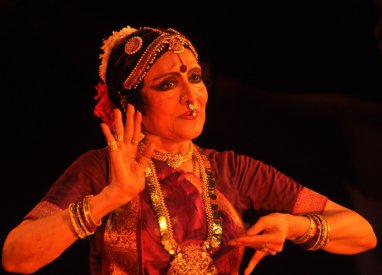 Vyjayanthimala Bali 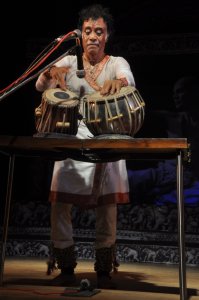 Pt. Chitresh Das Day 4 After a fusion concert by flautist-duo Pankaj and Paras Nath, a Kathak solo recital by veteran dancer Pt. Chitresh Das followed. The Kolkata-born California-based dancer decided to interact with the audience in his mother tongue all through his program. More like a lec-dem and less of a performance, it turned out to be a bit loud and noisy to handle at times. Pandit Das has amazing sense of rhythm and energy to hold forth when he exhibits his dance. He opened his performance with an obeisance to Lord Shiva ‘Harhar Mahadeva Shankar.’ Giving the audiences glimpses into his style of the dance form, the taiyaari, the layakaari, the khoobsurti and the nazaakat, he displayed commendable footwork. Performing a thaat and a padhant to the count of ascending and descending notes (aarohan and avrohan) in the beat of 1-8, 1-7, 1-6, 1-5 and so on, one could see remarkable tatkaar in his feet. However, his aggressive verbal stances lessened the poetic nature in which the tatkaar is usually delivered. Pandit Das’s attempt at a gat-bhaav in the story of ‘Shakuntala and Dushyanta’ also didn’t match up to his genius. While one was impressed by the sounds of the hoofs of horses Dushyanta arrives on, the abhinaya of a coy Shakuntala didn’t come across as expressive as it needed to be. Continuing his performance into displaying the journey of a steam engine, how it makes its exit from one station, paces in varying speeds, how it gets crossed by an electric train and how it slows down into another station, Pandit Das’s flair for overwhelming stayed consistent. Using a steady rhythmic flow with the percussionist in talas of the Trisra jaati, chatusra jaati and Khanda jaati, one could see his years of strenuous riyaaz coming to his aid. He followed this up with what he termed ‘Kathak Yoga’ that he designed inspired by a sadhu in Kolkata. Synchronizing his footwork to his verbal percussion and these two to a tabla he was playing on a table in front of him, Pandit Das provided a visual spectacle. Singing a composition of his father’s ‘Kailasa vaasa gowri shankara nandi vaahana’ interspersed with thekas on the tabla, Pandit Das once again dealt with balancing various taals in his multi-tasking display. He ended his concert with an old Kirtan that is popularly sung amongst the ISKCON followers of Bengal ‘Sri Krishna chaitanya, prabhu nityananda’, that was a childhood memory for Pandit Das. Day 5 The last day of the festival opened with the ‘Guru Kelucharan Mohapatra Award’ ceremony. This year the awards were bestowed on two eminent contributors for their lifetime services to their respective art forms: Octagenarian Gotipua Guru Birabara Sahoo for dance and Rama Chandra Patihari for his contribution to Odia theatre. The chief minister of Odisha, Shri Naveen Patnaik, and the minister for tourism and culture Shri Maheswar Mohanty, and Ashok Kumar Tripathy, the enthusiastic principal secretary, Tourism and Culture, gave away a purse of fifty thousand rupees to the awardees. 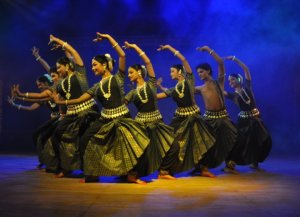 After the awards ceremony the young and talented dancers from the Srjan group opened their performance with ‘Bho Shambho’, a composition of Swami Dayananda Saraswathy set to Revathy ragam. With wonderful music and vocals by Debashish Sarkar, the dancers paid their obeisance to the Devi in Adi Shankara’s famous ‘Anandalahiri’. However the richness of the music didn’t seem to match the slow choreography in this piece. Added to that, the quality of lighting kept the dancers in the dark every time they formed a frieze of the Devi towards the end of the item. This was followed by their new work ‘Bishwas’ themed around the idea of faith and communal harmony. Taking inspiration from the holy texts like the Bible, the holy Quran and sayings from the Gurbani, a smartly choreographed narrative established a dialogue between the devotee in search of the truth and the lord who replies saying he can be found within. The neo-classical style of choreography took inspiration from both classical and contemporary forms of dance. Be it tunes from the Tulsidas’s Ramcharitmanas or a traditional sajda from the namaaz, a Christ dragging the cross up the mount (effectively displayed by Rinku Kumar Sahu and Sanjay Kumar Behara), an overwhelming visual delight came forth in Srjan’s new presentation, with their dancers effortlessly displaying their training in the performance. The piece culminated in the immortal lines of poet saint Kabir , ‘Mohko kahan dhoonde re bande, main tho bishwaas mein’ to say how the idea of god is sustained through the human emotion of faith, the dancers get into the ecstatic swinging of the Sufi whirling dervishes. While the theme is not a new one in dance, the freshness of its choreography (by none other than Ratikant Mohapatra), the striking costumes and the music kept everyone wanting for more. With a bunch of excellent, well-trained and polished dancers, this production is one of the best that has come out in the recent times from Odisha. It certainly deserves to be touring other places as the theme and message it chose to convey are highly relevant for the times. With this, the five-day long and 18th edition of the most popular festival came to a colorful conclusion with the audiences eagerly looking forward to the next edition. Kudos to Guru Ratikant Mohapatra and his efficient team of art lovers and volunteers who made the festival a grand success! Wish them all the best for the next! Veejay Sai is a writer, editor and a culture critic. |